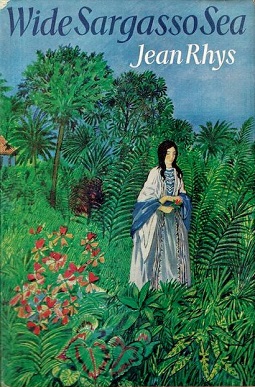While reading Rhys’ Wide Sargasso Sea I immediately noticed all the footnotes on
Charlotte Bronte’s Jane Eyre. I read the children’s version of Jane Eyre during the summer before my
eight grade year, so I was able to draw a few parallels from what little I
remembered about it. I also vaguely
remembered “The Simpsons” as making some sort of parody of Jane Eyre (which frankly might only be because I know they poke fun
at all sorts of widely acclaimed literature, such as The Raven by Poe or A Streetcar
Named Desire by Williams). It turns
out I was correct, and in one episode where Marge joins a book club, and the
book they are reading is “Jane Eyrehead.”
This revelation prompted me to further research just how prevalent Jane Eyre has stayed over the years
since it was written. Rhys obviously was
impacted by it over a century late when she published Wide Sargasso Sea in 1966, and clearly the writers of “The Simpsons”
saw it as pop culturally relevant a few decades after that. Even now the tale is in our media, with the
1993 film of WSS and a 2011 movie of Jane Eyre. There
are so many different versions of Jane
Eyre such as sequels, prequels, and spinoffs in so many different formats,
like movies, TV shows, and books.
Jane Eyre Summary and Examples of Versions As Wide
Sargasso Sea is the only work I have read, that is the one I’m going to be
focusing on. I found it really fascinating
that a book about the “crazy wife in the attic” had so many similarities to the
Jane Eyre I remember reading about half a dozen years ago. One thinks of them as completely separate people,
but Rhys chose to illustrate them as having more similarities than would be
comforting had people taken the time to notice them. (By this I merely mean that nobody wants to
be like the crazy lady, that they are supposedly not normal people ever, and no
sane person should share any similarities of past or present with them). Jane Eyre was orphaned at a young age, and
Antoinette’s father had died, and her mother was not a supportive force in her
life even before she passed. When Jane
has nowhere to live, she goes to a charity school, and when Antoinette has
nowhere to stay she goes to a convent school.
“This convent was my refuge, a place of sunshine and of death where very
early in the morning the clap of a wooden signal woke the nine of us who slept
in the long dormitory” (33). I found it
interesting that Antoinette thought of it as a refuge, and Jane’s school is her
refuge from her abusive aunt. In the
schools both Jane and Antoinette knew a Helen/Helene (respectively). Both ended up as rich women upon the death of
their family. When they reach adulthood
Jane and Antoinette (Bertha)’s lives intercross and the similarities of where
they live (Thornfield Hall) are inevitable.
It is more interesting to me that their lives have so many similarities
in the younger years, in Rhys’ mind at least.
As Wide
Sargasso Sea is the only work I have read, that is the one I’m going to be
focusing on. I found it really fascinating
that a book about the “crazy wife in the attic” had so many similarities to the
Jane Eyre I remember reading about half a dozen years ago. One thinks of them as completely separate people,
but Rhys chose to illustrate them as having more similarities than would be
comforting had people taken the time to notice them. (By this I merely mean that nobody wants to
be like the crazy lady, that they are supposedly not normal people ever, and no
sane person should share any similarities of past or present with them). Jane Eyre was orphaned at a young age, and
Antoinette’s father had died, and her mother was not a supportive force in her
life even before she passed. When Jane
has nowhere to live, she goes to a charity school, and when Antoinette has
nowhere to stay she goes to a convent school.
“This convent was my refuge, a place of sunshine and of death where very
early in the morning the clap of a wooden signal woke the nine of us who slept
in the long dormitory” (33). I found it
interesting that Antoinette thought of it as a refuge, and Jane’s school is her
refuge from her abusive aunt. In the
schools both Jane and Antoinette knew a Helen/Helene (respectively). Both ended up as rich women upon the death of
their family. When they reach adulthood
Jane and Antoinette (Bertha)’s lives intercross and the similarities of where
they live (Thornfield Hall) are inevitable.
It is more interesting to me that their lives have so many similarities
in the younger years, in Rhys’ mind at least.
No comments:
Post a Comment